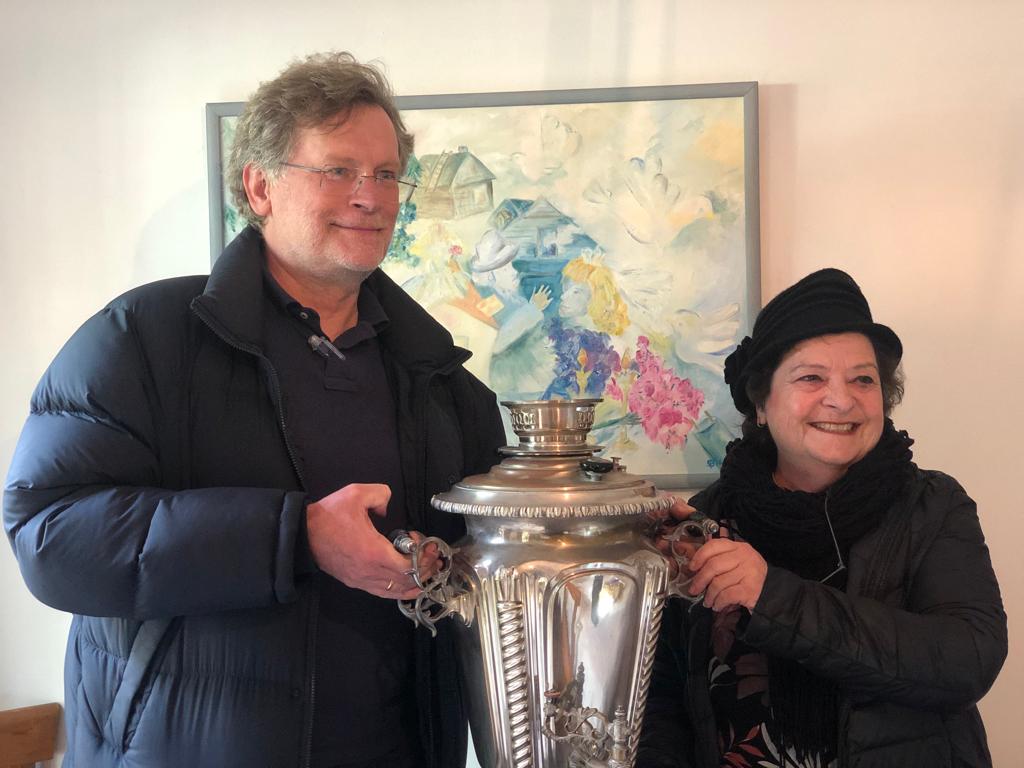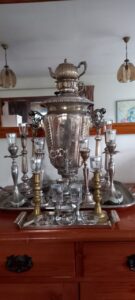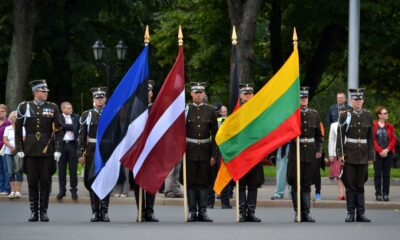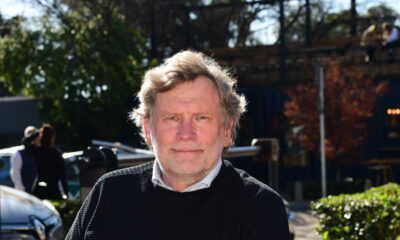
World

Samovar seals family history in Shadova
Published
10 months agoon
An elaborate samovar, otherwise known as a Russian tea urn, is being escorted from Cape Town to Lithuania by the outgoing Lithuanian ambassador to South Africa to the region it’s believed to have come from.
The samovar is going to Šeduva/Shadova in Lithuania, which once had a bustling Jewish community, and will be displayed in a new museum recording the lost world of the Jewish shtetls. For Capetonian Sue Benatar, it’s a bittersweet moment, as she inherited the samovar from her grandmother.

She decided to send the heirloom to be part of the Lost Shtetl Museum in Šeduva/Shadova – the village where her bobba came from – so that it could symbolise the heartache, loss, hope, and renewal of Jewish life in the 20th century.
Ambassador Dainius Junevičius, who has done much to mend the relationship between Lithuania and South African Jewry, is to take the samovar back with him to Lithuania to be part of the museum chronicling our history. This is his last act as ambassador before he retires.
“My bobba, Shasa Tzippa Shapiro [nee Zall], had to leave her own beautiful samovar in Lithuania when she came to South Africa in May 1939, just escaping the Holocaust,” says Benatar. Shapiro, her husband, and their children settled in Bulawayo and managed to build a new life. “She was heartbroken to have left her samovar behind. Years later, while on holiday in Muizenberg, she saw almost the exact same samovar for sale, and my grandfather bought it for her.”
The samovar was Shapiro’s pride and joy and symbolised what was lost. Her brother was killed in the Holocaust, shot in the forest with his wife and children. For the survivors and the friends Shapiro made in her new home, it symbolised tradition and connection to the past. “Every second-day Rosh Hashanah, my bobba made lemon tea with the samovar, and the women would drink it with grape jam stirred in or holding a sugar cube between their teeth and sucking the tea through the sugar cube.”
Benatar and her grandmother were close, and she loved hearing stories from “the old country”. So it meant a lot to Benatar when she inherited the samovar, which she kept polished and in pride of place. “My husband and I are now scaling down and our children don’t have the space to keep the samovar. It was too precious to sell,” she says. Benatar was unsure what to do with it, but then the answer fell into her lap.
“I went on a whirlwind trip to Lithuania in 2015, and met a Lithuanian man who was tasked with restoring the Jewish cemetery and overseeing the memorials in the forests where the Jews of Šeduva/Shadova were killed. He later met Lost Shtetl Museum Chief Curator Milda Jakulytė-Vasil. He mentioned that he had met some South African Jews, and she asked to get in contact.”
The result was that Benatar’s grandmother’s story will now be featured in the museum. “I’ve always been the family archivist, so I was able to provide a lot of photos and documentation,” says Benatar. The museum team even filmed her telling her grandmother’s story. And then, when Benatar was thinking of what to do with the samovar, she realised that the perfect solution was to allow it to be part of the museum in the very town where the family’s original samovar was left behind as it fled the Holocaust.
“Sue and I became friends a number of years ago when I started working at the Lost Shtetl Museum, looking for information about the people who lived in the town,” says Jakulytė-Vasil. “In 2017, our team visited South Africa, where we met descendants of the Jews of Šeduva, including Sue‘s family.
“During these meetings, the descendants shared their family stories and showed photos and relics of their grandparents. They even gave us a few of them. So I was delighted to receive a call from Sue when she said that she had decided to donate her grandmother‘s samovar to us. We‘re happy to have the help of Lithuanian Ambassador Dainius Junevičius in bringing this exhibit to Lithuania.”
The Lost Shtetl Museum will open its doors in 2024. The name was chosen to reflect the disappearance of Jewish communities that were destroyed during the Holocaust in Lithuania and throughout Eastern Europe during World War II.
The museum will present the history, culture, religion, folklore, and daily life of the Jews of Lithuania’s shtetls and their relations with their neighbours – an entire way of life that ended with the Holocaust. The museum’s exploration of daily shtetl life is based on the many stories of the Jews of Šeduva/Shadova. This is why the museum is being built there. The museum is privately funded, supported by a group of Jewish businesspeople in Switzerland whose ancestors lived in Šeduva/Shadova.
During the period between the two world wars, about 7 000 Litvaks left Šeduva for South Africa, and the museum includes many of their stories. For example, Mendel Berkow came to South Africa in 1902. Until the end of his life in 1976, he drove a horse-drawn cart, as he was accustomed to do in the village. Berkow brought religious books to South Africa, and passed them on to his children. These will now return to Šeduva and be on display in the museum.
The Jews who were left behind were decimated. Five hundred years of Jewish life in the village ended in just two days of slaughter. German forces entered Šeduva on 25 June 1941, and exactly two months later, the Jews were loaded onto trucks and taken to Liaudiškiai, 10km south-west of the town. The entire Jewish community was shot and buried in two pre-prepared mass graves. Two hundred and thirty Jewish men, 275 Jewish women, and 159 Jewish children were killed – a total of 664 people.
The museum meticulously attempts to capture what was lost, and many stories are recorded on its website. Benatar hopes to visit the museum when it opens this time next year. Not only that, she’s writing and illustrating a children’s book about the samovar and its journey back to Lithuania.
Everything fell into place to get the samovar to Lithuania when Junevičius offered to take it back with him. A few weeks ago, he came to Benatar for tea, where she handed over the magnificent heirloom. “I was filled with extreme emotion,” says Benatar. “I was so close to my bobba, and having her samovar felt like she was there with me. But at the same time, this feels like the perfect solution. It will be displayed in the section on my grandmother’s family. It’s going home.”










